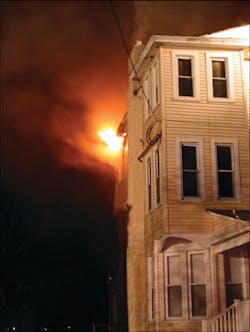Making the Most of the Three Person Company - Part 1
Staffing in the fire service has dwindled because of numerous reasons over the past few decades. An engine or ladder company arriving with half a dozen personnel was once the norm; it is now a rarity. Both in the career fire service as well as the volunteer fire service, we are responding with less and less resources. Specific National Fire Protection Association (NFPA) standards can be used to justify resources and staffing whether the department is career or volunteer. Let's take a look at some of these sources that can be of value in our justification process.
NFPA Standards Wide Array Of Standards
To the advantage of the career fire service, NFPA 1710: Standard for the Organization and Deployment of Fire Suppression Operations, Emergency Medical Operations, and Special Operations to the Public by Career Fire Departments, has identified "minimum requirements" for engine and ladder company staffing. A minimum of four personnel are identified as the minimum safe requirement and this staffing level is even furthermore enhanced to five or, even, six personnel in areas more prone to fire activity or with additional risk (see, sections 5.2.3.1.1 and 5.2.3.1.2 for engine companies and 5.2.3.2.1 and 5.2.3.2.2 for ladder companies, 2010 edition).
While also providing guidance, NFPA 1720: Standard for the Organization and Deployment of Fire Suppression Operations, Emergency Medical Operations and Special Operations to the Public by Volunteer Fire Departments, is geared towards the volunteer fire service and discusses minimum requirements for personnel at the fire scene and goes into depth as it relates to personnel needed within specific time frames. For example, an urban area is classified as having greater than 1,000 people per square mile and requires 15 personnel within the first nine minutes of operation for a fire in a "low hazard" occupancy (see section 4.3.2 and Table 4.3.2, 2010 edition).
What is good about these standards is that they offer a defense for the ever-heavy budget axe. No, these NFPA standards are not laws like those of OSHA for example and as such we are not mandated to adhere to them. But, there is an advantage here for senior level department leadership who must go toe-to-toe with the municipal bean counter. Elected officials usually strive to do what's best for the community as a whole and if there is no requirement or minimum standard for a particular resource, they will not voluntarily give it to you. However, the higher up one goes in any organization, the greater the potential liability.
Our elected leaders are no different than anyone else as it relates to not wanting to be identified as the culprit or primary person responsible for a disaster. Therefore, we must use the system to our advantage. Take for example the apparatus or personal protective equipment (PPE) your department purchases or the training of your firefighters. The major apparatus manufacturers make apparatus that meet NFPA 1901: Standard for Automotive Fire Apparatus; our PPE is made to NFPA 1851: Standard on Selection, Care, and Maintenance of Protective Ensembles for Structural Fire Fighting and Proximity Fire Fighting minimum standard, and our regional training facilities turn out firefighters with training that meets NFPA 1001: Standard for Fire Fighter Professional Qualifications. In addition, we use the incident management system (IMS) where the most minimum requirements are identified in NFPA 1561: Standard on Emergency Services Incident Management System, and as it relates to safety, the great majority of our departments use NFPA: 1500 Standard on Fire Department Occupational Safety and Health Program as the primary building block for organizational safety.
So, what am I getting at here? I am saying that there are many resources out there that can be used to support our case for needed resources, including staffing. These standards don't mandate your organization to do anything, but they do offer you aid in supporting your cause. How can you constantly be relying on the above standards and then be told that the staffing issues as spelled out in NFPA 1710 or 1720 are not relevant or not necessary for life safety? To pick and choose what you like versus what you don't like seems to be a problematic and potentially costly mistake in the long run.
As it relates to liability, our leaders may say that yes, it is true that the fire service does have standards that safeguard its personnel. But the cry of "there is no money to support what we presently have," "there is the fear of layoffs," "cutbacks," "no vehicle replacements," and the reasons go on and on. Staffing levels promote safety and we must use all the resources out there to further our cause, but what do we do in the mean time?
The Unfortunate Real World
We are responding with very limited numbers of personnel to our daily emergencies (see Figure 1). Only a small percentage of departments have the luxury of staffing. The key to our success must then be based on "thinking outside the box." Engine and ladder companies that have limited numbers of firefighters have to be used to the greatest effect. What we'll tackle here, in this multi-art series, is how to make the most of the three-person engine and ladder companies.
Let's use a rather serious, but not out of the ordinary scenario - a fire in a three-story apartment building. The building is a three-story ordinary constructed, unsprinklered occupancy. It has an open interior stairwell that penetrates the roof via a bulkhead door. There are four apartments per floor. The fire is in a living room of one apartment on the third floor and is extending to a bedroom room via the apartment hallway. The time is 2 a.m. and the building is occupied and two residents are showing from the "A" side windows of the top floor. There are no attached exposures. When one of the occupants fled, they left the apartment door open and fire is extending into the common third floor hallway. The hallway is choked with smoke and high levels of heat, and visibility is very poor. What specific engine and ladder company tasks are required at such a fire?
- Primary sustained water supply
- Secondary sustained water supply
- 1 3/4-inch handline stretched to the seat of the fire
- 1 3/4-inch backup line stretched to support the attack and for personnel safety
- 1 3/4-inch line to the floor above (if applicable), or into the most severely exposed exposure (we should be prepared to put three lines into operation at every building fire we go to)
- Vertical and horizontal ventilation for this particular scenario
- Conduct forcible entry operations both into the building and into the fire area
- Conduct a primary and secondary search for victims
- Provide multiple means of additional egress and exit using both aerial and ground ladders
- Perform pre-and post-control overhaul
- Control utilities such as gas and electric
- Perform salvage to prevent further damage
- Provide lighting both inside and outside the building
From this list, it is obvious that any effective operation relies on a sufficient number of resources. Resources in this situation translates into proper equipment and apparatus, and most importantly, sufficient numbers of trained firefighters and fire officers.
In the next few articles, we'll take a look at getting the most of the three person engine and ladder companies. It's obvious that the more "resource heavy" you are initially, the safer both you and the public are. But what do you do if you have only three person companies? In this series that is precisely what we'll study. This series is a brief overview and is based on the safety of our firefighters and the efficiency of our organizations. We'll look at operations from the more typical tasks required. More unusual operations such as a fire in a commercial occupancy and fires in high-rise buildings may demand a slight change in tactics. Nevertheless, the principle of teamwork is critical for success.
ARMAND F. GUZZI, Jr. has been a member of the fire service since 1987. He is a career firefighter with the City of Long Branch, NJ, and is an instructor for the Monmouth County, NJ, Fire Academy, where he has taught since 1990. He has a Masters Degree in Management and undergraduate degrees in Fire Science, Education, and Business Administration. You can reach Armand by e-mail at: [email protected].
About the Author

Armand Guzzi
Firehouse.com Contributor
Armand F. Guzzi, Jr. has been a member of the fire service since 1987. He recently retired a career fire lieutenant with the City of Long Branch, NJ, Fire Department and is the deputy director of the Monmouth County, NJ, Fire Academy where he has taught for over 20 years. He has a Master's degree in management and undergraduate degrees in fire science, education, and business administration. View all of Armand's articles here. He can be reached via e-mail at [email protected] or [email protected].
